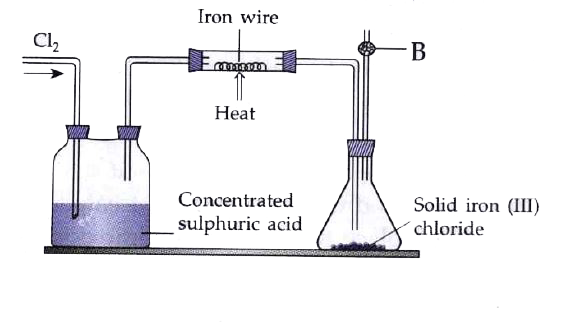Iron forms iron (II) chloride, and iron (III) chloride . One of these chlorides is a dark brown solid, melting point . The other is a white crystalline solid with greenish tint, melts at Which description best fits iron (II) chloride Explain.
To determine which description best fits iron (II) chloride (FeCl₂) and to explain the reasoning, we can follow these steps:
Step 1: Identify the properties of iron (II) chloride (FeCl₂) and iron (III) chloride (FeCl₃).
- Iron (II) chloride (FeCl₂) is commonly known as ferrous chloride.
- Iron (III) chloride (FeCl₃) is commonly known as ferric chloride.
Step 2: Analyze the given descriptions.
- One chloride is described as a dark brown solid with a melting point of 306°C.
- The other is described as a white crystalline solid with a greenish tint and a melting point of 674°C.
Step 3: Match the properties to the correct iron chloride.
- FeCl₂ (ferrous chloride): It is typically a white crystalline solid, often with a greenish tint due to impurities or oxidation. It has a higher melting point due to the stronger ionic bonds in the crystalline structure.
- FeCl₃ (ferric chloride): This compound is known to be a dark brown solid, which aligns with the first description.
Step 4: Conclude which description fits FeCl₂.
- Based on the analysis, iron (II) chloride (FeCl₂) is best described as the white crystalline solid with a greenish tint, which has a higher melting point of 674°C. In contrast, iron (III) chloride (FeCl₃) is the dark brown solid with a melting point of 306°C.
Final Answer:
Iron (II) chloride (FeCl₂) is best described as the white crystalline solid with a greenish tint that melts at 674°C.
---
- Iron (II) chloride (FeCl₂) is commonly known as ferrous chloride.
- Iron (III) chloride (FeCl₃) is commonly known as ferric chloride.
- One chloride is described as a dark brown solid with a melting point of 306°C.
- The other is described as a white crystalline solid with a greenish tint and a melting point of 674°C.
- FeCl₂ (ferrous chloride): It is typically a white crystalline solid, often with a greenish tint due to impurities or oxidation. It has a higher melting point due to the stronger ionic bonds in the crystalline structure.
- FeCl₃ (ferric chloride): This compound is known to be a dark brown solid, which aligns with the first description.
- Based on the analysis, iron (II) chloride (FeCl₂) is best described as the white crystalline solid with a greenish tint, which has a higher melting point of 674°C. In contrast, iron (III) chloride (FeCl₃) is the dark brown solid with a melting point of 306°C.
Iron (II) chloride (FeCl₂) is best described as the white crystalline solid with a greenish tint that melts at 674°C.
Topper's Solved these Questions
- D AND F BLOCK ELEMENTSBOOK - CENGAGE CHEMISTRY ENGLISHCHAPTER - D AND F BLOCK ELEMENTSEXERCISE - Ex 6.2 Subjective (Compound Of Cu:)
3 Videos
- D AND F BLOCK ELEMENTSBOOK - CENGAGE CHEMISTRY ENGLISHCHAPTER - D AND F BLOCK ELEMENTSEXERCISE - Ex 6.2 Subjective (Compound Of Zn:)
1 Videos
- D AND F BLOCK ELEMENTSBOOK - CENGAGE CHEMISTRY ENGLISHCHAPTER - D AND F BLOCK ELEMENTSEXERCISE - Ex 6.1 Subjective
12 Videos
- COORDINATION COMPOUNDSBOOK - CENGAGE CHEMISTRY ENGLISHCHAPTER - COORDINATION COMPOUNDSEXERCISE - Archives Subjective
18 Videos
- ELECTROCHEMISTRYBOOK - CENGAGE CHEMISTRY ENGLISHCHAPTER - ELECTROCHEMISTRYEXERCISE - Archieves Subjective
35 Videos
Similar Questions
How does ammonium hydroxide help in distinguish between:
Iron (II) chloride and Iron (III) chloride.
View SolutionWhich of the following can produce a colour change from yellowish brown to light green in acidified aqueous solution of iron (III) chloride?
View SolutionGive one chemical test to distinguish between the following pairs of compounds.
Iron (II) chloride solution and Iron (III) chloride solution.
View SolutionSelect from the list given (A to E) one substance in each case which matches the description given in parts (i) to (v). (Note: Each substance is used only once in the answer.
(A) Nitroso iron (II) sulphate (B) Iron (III) chloride
(C) Chromium sulphate (D) Lead (II) chloride (E) Sodium chloride
(i) A compound which is yellow brown.
(ii) A compound which is insoluble in cold water, but soluble in hot water.
(iii) The compound responsible for the brown ring during the ring test of nitrate ion.
(iv) A compound whose aqueous solution is neutral in nature.
(v) The compound which is responsible for the green colouration when sulphur dioxide is passed through acidified potassium dichromate solution.
View SolutionIron react with hydrogen chloride gas forming_______[iron [II] chloride , iron [III] chloride]and hydrogen .The reaction is an example of ________ [double decomposition , synthesis , single displacement].
View SolutionFill up the blank with the correct choice given in bracket. The salt prepared by the method of direct combination is ______
(iron (II) chloride/ iron (III) chloride)
View SolutionThe given diagram is to prepare Iron(III) chloride in the laboratory:
(i) What is substance B?
(ii) What is the purpose of B?
(iii) Why is iron(III) chloride to be stored in a closed container?
(iv) Write the equation for the reaction between iron and chlorine.

View SolutionElement X forms a chloride with the formula XCl2, which is a solid with a high melting point. X would most likely be in the same group of the Periodic Table as
View SolutionWrite balanced chemical equations for the preparation of the following compounds (as the major product) starting from iron and using only one other substance:
Iron (II) chloride
View SolutionWrite balanced chemical equations for the preparation of the following compounds (as the major product) starting from iron and using only one other substance:
Iron (III) chloride
View Solution
